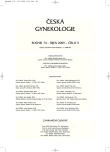Ultrasound-guided tru-cut biopsy in the treatment of abdomino-pelvic advanced tumors
Authors:
D. Fischerová 1; D. Cibula 1; Michal Zikán 1; P. Freitag 1; J. Sláma 1; N. Jančárková 1; I. Pinkavová 1; P. Dundr 2
Authors‘ workplace:
Onkogynekologické centrum, Gynekologicko-porodnická klinika VFN a 1. LF UK, Praha, přednosta prof. MUDr. A. Martan, DrSc.
1; Ústav patologie VFN a 1. LF UK, Praha, přednosta prof. MUDr. C. Povýšil, DrSc.
2
Published in:
Ceska Gynekol 2009; 74(5): 329-334
Overview
Objective:
The goal of this study was to evaluate the accuracy and safety of ultrasound-guided tru-cut biopsy in advanced abdomino-pelvic tumors in a sufficiently large cohort.
Design:
Prospective study.
Setting:
Oncogynecological Center, Department of Obstetrics and Gynecology, General Faculty Hospital of Charles University, Prague.
Methods:
Patients indicated for tru-cut biopsy were those with primarily inoperable tumors, with advanced tumors and compromised performance status preventing a primary surgical procedure, and with recurrent pelvic tumors requiring histological verification. All were referred to the Oncogynecological Center between January 2005 and June 2007. Tru-cut biopsy was taken either from pelvic tumor or from its metastatic sites transvaginally or transabdominally under ultrasound guidance. Sample adequacy was evaluated.
Results:
Altogether, 119 patients were referred for tru-cut biopsy during a study period. Only 4 cases were found unsuitable for tru-cut biopsy and the patients were referred for laparoscopy instead. Samples were obtained transvaginally in 67 patients (58.3%) and transabdominally in 48 patients (41.7%). The biopsy was taken from pelvic tumor in 59 patients (51.3%), omental cake in 14 patients (12.2%), from peritoneal visceral or parietal carcinomatosis in 37 patients (32.2%) and from other localities in 5 patients (4.3 %). The diagnostic adequacy of ultrasound-guided tru-cut biopsy reached 94.8% (95% CI, 94,17–99,40%). There were only two tru-cut biopsy-related complications: The first case involved bleeding from tumor in a patient with mild thrombocytopenia that required laparotomy; in the second case, diagnostic laparoscopy was indicated after a minor bleeding occurred in the biopsy site on ultrasound, however, no significant pelvic bleeding was confirmed by the procedure.
Conclusion:
Ultrasound-guided tru-cut biopsy is a safe, reliable, fast, and cost-effective diagnostic method for histological verification of both advanced primary and recurrent abdomino-pelvic tumors. It can be performed in an outpatient setting without the need for general anesthesia, causing a minimal discomfort to the patient in comparison with laparoscopy or laparotomy. The risk of complications is low and the main advantage is the acquirement of a sample adequate for further immunohistochemical examination, which is a necessary requirement for the choice of optimal oncological treatment.
Key words:
advanced abdomino-pelvic tumor, ovarian cancer, extraovarian tumours, recurrent tumor, tru-cut biopsy, ultrasound, staging, prediction of operability.
Sources
1. Anastasiadis, AG., Lichy, MP., Nagele, U., et al. MRI-guided biopsy of the prostate increases diagnostic performance in men with elevated or increasing PSA levels after previous negative TRUS biopsies. Eur Urol, 2006, 50, p. 738-748.
2. Anwer, A., Naik, R., Athavale, R., et al. Laparoscopic biopsy versus image guided biopsy in diagnosis of suspected ovarian cancer [abstract]. Int J Gynecol Cancer, 2005, 15, 103. Abstract 000187.
3. Fischerová, D. Ultrazvukové vyšetření benigních a maligních ovariálních nádorů. Moderní Gynek Porod, 2007, 16, 4, s. 740-758.
4. Fischerová, D. Diagnostika a staging v onkogynekologii. Moderní Gynek Porod, 2007, 16, 3, s. 517-533.
5. Fischerová, D., Burgetová, A., Seidl, Z., Bělohlávek, O. Diagnostika. In Cibula, D. Onkogynekologie, 1.vyd. Praha: Grada publishing, 2009, s. 101-131.
6. Fischerová, D. The role of ultrasound in prediction of optimal vs suboptimal cytoreductive surgery in advanced ovarian cancers [abstract]. Ultrasound Obstet Gynec, 2008, 32, 3, p. 286. Abstract OC 132.
7. Fischerová, D., Zikán, M. Sonohysterografie a minimálně invazivní výkony pod ultrazvukovou kontrolou. Moderní Gynek Porod, 2007, 16, 4, s. 758-764.
8. Floery, D., Helbich, TH. MRI-guided percutaneous biopsy of breast lesions: materials, techniques, success rate, and management in patients with suspected radiologic-pathologic mismatch. Magn Reson Imaging Clin N Am, 2006, 14, p. 411-425.
9. Guthrie, CG. Gland puncture as a diagnostic measure. Johns Hopkins Hosp Bull, 1921, 366, p. 269.
10. Chojniak, R., Isberner, RK., Viana, LM. et al. Computed tomography guided needle biopsy: experience from 1.300 procedures. Sao Paulo Med J, 2006, 124, p. 10-14.
11. Kurtz, AB., et al. Diagnosis and staging of ovarian cancer: comparative values of doppler and conventional US, CT a MR imaging correlated with surgery and histopathologic analysis – report of the Radiology Diagnostic Oncology Group. Radiology, 1999, 212, p. 19-27.
12. Malmström, H. Fine - needle aspiration cytology versus core biopsies in the evaluation of recurrent gynecologic malignancies. Gynecol Oncol, 1997, 65, p. 69-73.
13. Sauthier, PG., Bélanger, R., Provencher, DM., et al. Clinical value of image-guided fine needle aspiration of retroperitoneal masses and lymph nodes in gynecologic oncology. Gynecol Oncol, 2006, 103, p. 75-80.
14. Tempany, CMC., et al. Staging of advance ovarian cancer: comparison of imaging modalities – report from Radiological Diagnostic Oncology Group. Radiology, 2000, 215, p. 761-767.
15. Timmerman, D., Testa, AC., Bourne, T., et al. Logistic regression model to distinguish between the benign and malignant adnexal mass before surgery: a multicenter study by the International Ovarian Tumor Analysis Group. J Clin Oncol, 2005, 23, p. 8794-8801.
16. Valentin, L., Ameye, L., Jurkovic, D., et al. Which extrauterine pelvic masses are difficult to correctly classify as benign or malignant on the basis of ultrasound findings and is there a way of making a correct diagnosis? UOG, 2006, 27, p. 438-444.
17. Vergote, I., Marquette, S., Amant, F., et al. Port-site metastases after open laparoscopy: a study in 173 patients with advanced ovarian carcinoma. Int J Gynecol Cancer, 2005, 15, p. 776-779.
18. Votrubová, J., Hořejš, J., Sojáková, M., et al. Transrektální ultrasonografie a MR vyšetření rekta I.transrektální ultrasonografie. Čs Radiol, 2002, s. 25-26.
Labels
Paediatric gynaecology Gynaecology and obstetrics Reproduction medicineArticle was published in
Czech Gynaecology

2009 Issue 5
Most read in this issue
- Current knowledge of ductal carcinoma in situ
- Acute hysterectomy for huge submucous leiomyoma prolaps
- Cancer of endometrium - rare variant of remote metastases
- Early pregnancy loss and inherited thrombophilic states
